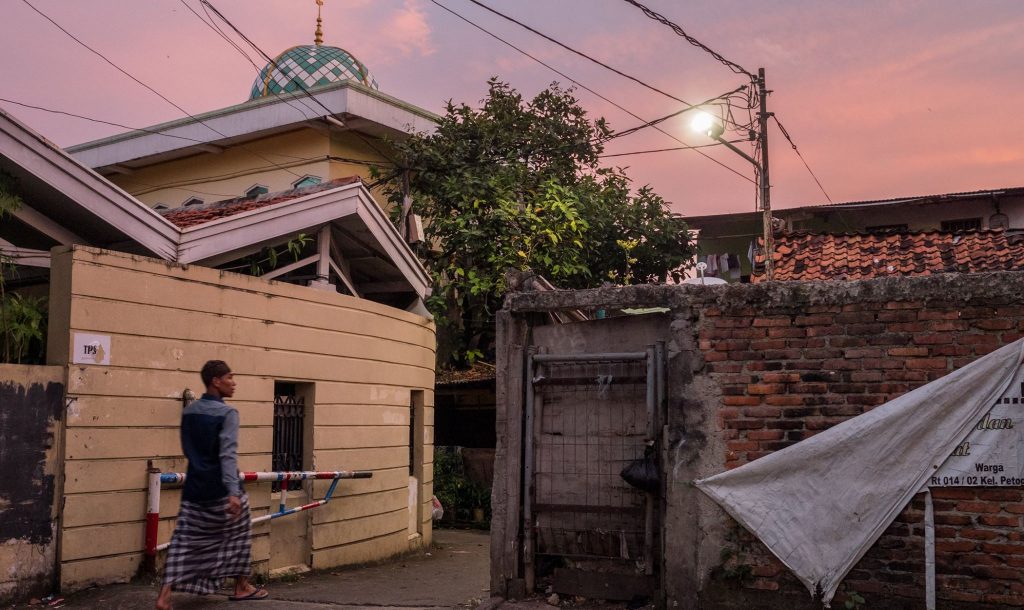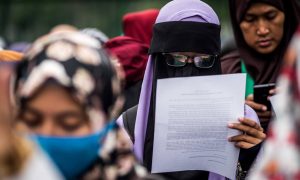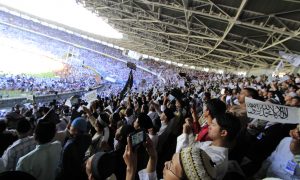The recent gubernatorial election in Jakarta has led many high profile observers to claim that Islam’s role in everyday life in Indonesia is deepening and, particularly, that the power of Islamists is increasing. Implicit in these stories is the reference to Indonesia’s past, in which a “moderate” form of Islamic practice was the norm. This description is understood as fact, and observers have not been shy about suggesting the causes. In a widely shared article, for example, Scott Shane of The New York Times suggested that a surge in Saudi Arabian money is being directed towards the construction of mosques and the funding of imams across the Muslim world. While few would dispute that the Saudis are funding the construction of mosques in Indonesia, many such stories seem to take for granted the idea that Islam’s reach is expanding in Indonesia, with little or no recourse to empirical evidence that systematically represents the scale of activity and the rate at which it is presently occurring.
Part of the problem is that religious life is a notoriously difficult thing to measure. I want to suggest that the construction of places of worship—mosques and mushollas, in particular—is a reasonably reliable indicator of religious life in Indonesia. Most obviously, these are the most visible sites of religious practice. But they also represent the culmination of what is often a community-driven effort to construct a place of worship, thereby reflecting their deeply held desires and aspirations.
The central statistics agency (Badan Pusat Statistik, or BPS) estimates the number of mosques and mushollas in Indonesia at 800,000, but this is an imprecise and aggregated figure subject to some doubt. The Indonesian Ministry of Religion has recently begun an effort to remedy the poor availability of records with an online database, Sistem Informasi Masjid (Mosque Information System, or SIMAS) that collects information on the size, construction date, and location of places of worship. It remains incomplete—mosques and mushollas are solicited to fill out a form, and only 423,000 have submitted their information. Worryingly, the missing data seems to skew towards districts in the periphery. But in absolute terms these are the least densely populated places, meaning they are likely to be the places that also have the weakest impact on the topline trends discussed in this post.
One of the most striking and counterintuitive trends to emerge from the data is that, at least since the fall of the New Order in 1998, the construction of new mosques and mushollas has dropped off precipitously. In the ten years before 1998, for example, there were 83,119 new mosques and mushollas built. But there were only 71,434 built in the ten years after 1998. This corresponds to a -1.5% annualised rate of decline in the construction of mosques and mushollas.
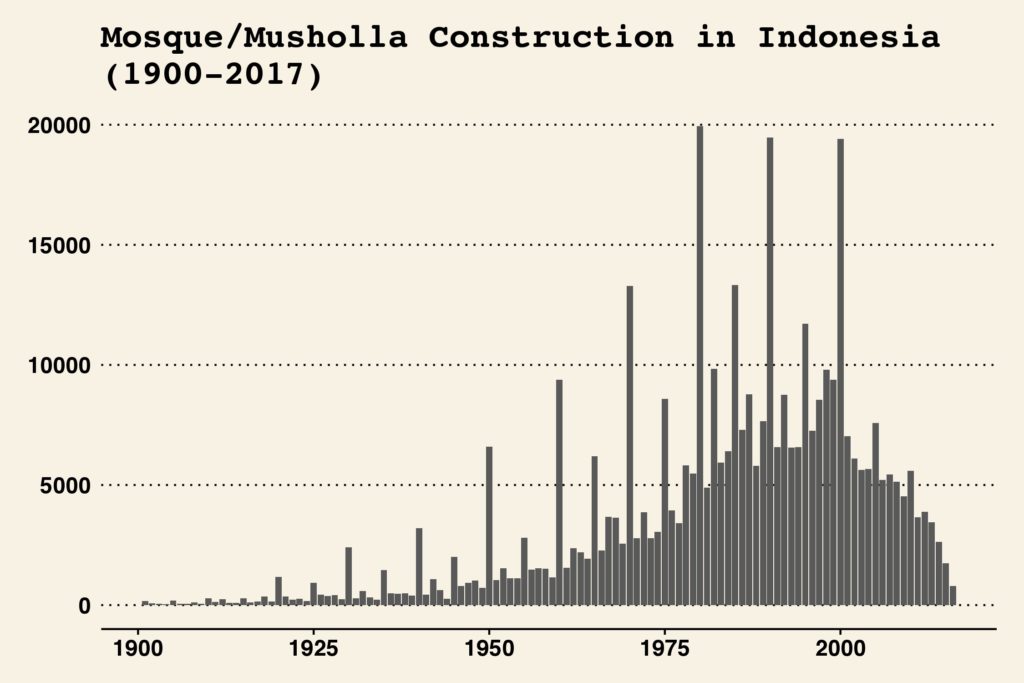
Figure #1. Source: http://simas.kemenag.go.id/. 423,809 mosques and mushollas in the dataset. This is a partial portrait of the estimated 700,000 mosques and mushollas in Indonesia. Spikes represent base-five years. Construction date relies on self-reports from mosque or musholla leaders, meaning they often offer estimates that cluster around base-five years.
What explains these trends? The decline could partly be a story about saturation. By 1998, the density of mosques might have reached such a level that there simply was no further demand for their construction—Indonesia might have simply had a sufficient number of places of worship to satisfy those looking for a nearby place to congregate and pray. But, oddly, the drop-off in mosque and musholla construction happened despite the fact that Indonesia’s total population has risen by at least 25% since the fall of Suharto. If mosques and mushollas were truly a function of their saturation, we ought to have seen their construction continue in line with population growth.
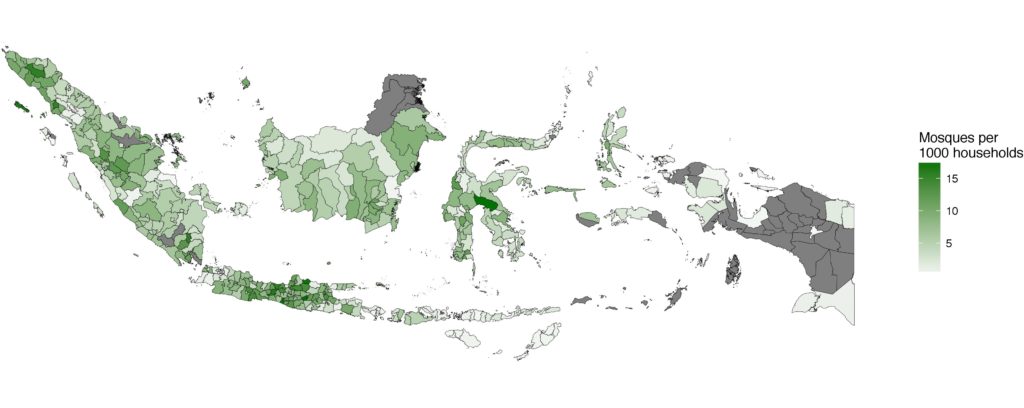
Figure #2: Mosque Density (per 1000 households) in Indonesia by Kabupaten, 2014. Grey kabupatens indicate missingness. Outliers removed (top 1% of kabupatens by density) to maintain scale. All outliers were in peripheral kabupatens. Household counts data drawn from 2014 Village Potential Statistics Survey (PODES).
The decline could also be a function of new regulations and changing availability of resources. From 1969 to 2006, the district-level executive—either a regent (bupati) or a mayor (walikota)—held the unilateral authority to issue permits for the construction of new places of worship. During the 1970s and 1980s, moreover, communities often received funding from the central government to fund the construction of mosques. This stands in contrast to the way things look today. Permits for the construction of places of worship are granted in consultation with an interfaith council, and funds from the central government have largely dried up thanks to a process of fiscal decentralisation. But, again, this explanation doesn’t entirely square with the decline in construction, since the regulatory change happened in 2006—eight years after the decline began, and the process of fiscal decentralisation didn’t start in earnest until 2004.
Of course, mosques and mushollas continue to be built. Scholars and journalists have frequently pointed to the construction of, say, a mosque in a contentious area of Java or other dense population centers, giving the impression that these are the signs of the deepening of Islamic faith. The spatial distribution of new mosques in the post-Suharto period, however, tilts towards the peripheral and rural districts in Indonesia [see Figure #3]. In other words, where it is occurring, the growth of mosques and mushollas is sharpest in the places observers seem to forget.
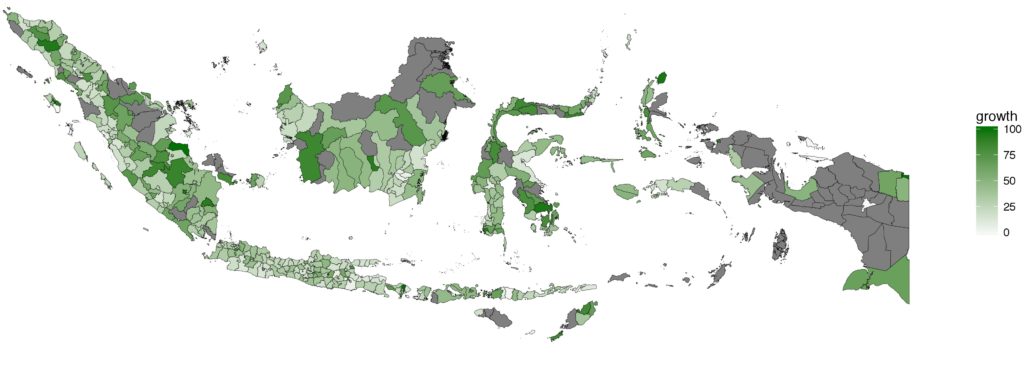
Figure #3. Grey kabupatens indicate missingness. Outliers removed (top 5% of kabupatens by growth) to maintain scale. All outliers were in Kalimantan, Sumatera, or Sulawesi.
The point here is that there is good reason to be sceptical of any claims about the deepening of Islam in public life as a uniform, Indonesia-wide phenomenon. If Islam were truly deepening its role in public life, we ought to at least expect the construction of places of worship to continue apace—but we don’t.
…………………………
Nick Kuipers is a PhD student in the department of political science at the University of California, Berkeley. Before returning to the United States, he worked at Saiful Mujani Research and Consulting in Jakarta as a researcher. He welcomes comments and can be reached via email.
Header image taken by Ray Yen.
 Facebook
Facebook  Twitter
Twitter  Soundcloud
Soundcloud  Youtube
Youtube  Rss
Rss 